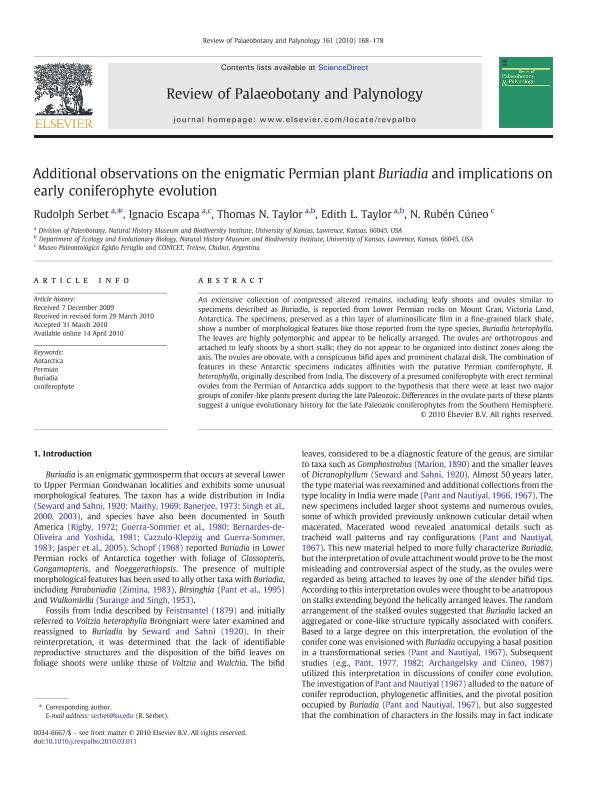Artículo
Additional observations on the enigmatic Permian plant Buriadia and implications on early coniferophyte evolution
Fecha de publicación:
07/2010
Editorial:
Elsevier Science
Revista:
Review of Palaeobotany and Palynology
ISSN:
0034-6667
Idioma:
Inglés
Tipo de recurso:
Artículo publicado
Clasificación temática:
Resumen
An extensive collection of compressed altered remains, including leafy shoots and ovules similar to specimens described as Buriadia, is reported from Lower Permian rocks on Mount Gran, Victoria Land, Antarctica. The specimens, preserved as a thin layer of aluminosilicate film in a fine-grained black shale, show a number of morphological features like those reported from the type species, Buriadia heterophylla. The leaves are highly polymorphic and appear to be helically arranged. The ovules are orthotropous and attached to leafy shoots by a short stalk; they do not appear to be organized into distinct zones along the axis. The ovules are obovate, with a conspicuous bifid apex and prominent chalazal disk. The combination of features in these Antarctic specimens indicates affinities with the putative Permian coniferophyte, B. heterophylla, originally described from India. The discovery of a presumed coniferophyte with erect terminal ovules from the Permian of Antarctica adds support to the hypothesis that there were at least two major groups of conifer-like plants present during the late Paleozoic. Differences in the ovulate parts of these plants suggest a unique evolutionary history for the late Paleozoic coniferophytes from the Southern Hemisphere.
Palabras clave:
ANTARCTICA
,
PERMIAN
,
BURIADIA
,
CONIFEROPHYTE
Archivos asociados
Licencia
Identificadores
Colecciones
Articulos(SEDE CENTRAL)
Articulos de SEDE CENTRAL
Articulos de SEDE CENTRAL
Citación
Serbet, Rudolph; Escapa, Ignacio Hernán; Taylor, Thomas N.; Taylor, Edith L.; Cúneo, Néstor Rubén; Additional observations on the enigmatic Permian plant Buriadia and implications on early coniferophyte evolution; Elsevier Science; Review of Palaeobotany and Palynology; 161; 3-4; 7-2010; 168-178
Compartir
Altmétricas




